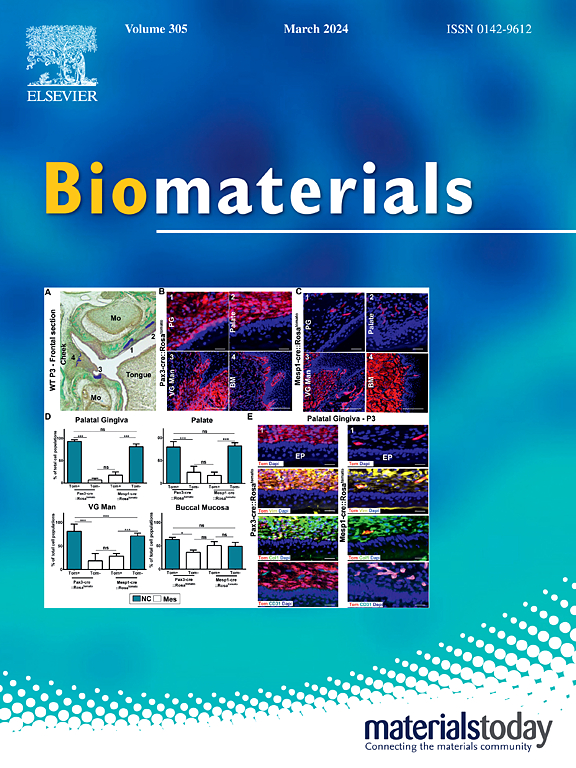金包埋的蛋黄壳介孔有机二氧化硅纳米复合材料用于肝癌的微波增强靶向化疗和免疫调节
IF 12.9
1区 医学
Q1 ENGINEERING, BIOMEDICAL
引用次数: 0
摘要
微波消融(MWA)是一种治疗肝细胞癌(HCC)的创新疗法,面临着热效应有限和肿瘤免疫抑制微环境的挑战。为了解决这些问题,我们开发了一种先进的Au@PMO@DOX-Lac纳米复合材料,旨在增强微波热效应,同时促进靶向化疗和免疫调节。该纳米复合材料结合了嵌入金的蛋黄壳介孔有机二氧化硅纳米颗粒,从两个方面增强了微波热效应:金-二氧化硅界面产生的分子热点和中空纳米结构内的限制效应。这些改进有助于更有效的肿瘤消融,减少微波功率要求和更短的治疗时间。此外,乳酸表面修饰和阿霉素负载使得纳米复合材料能够执行精确的、靶向的协同化疗。消融后,纳米复合材料增加了细胞毒性T细胞,减少了调节性T细胞,同时将巨噬细胞从免疫抑制性M2表型转变为抗肿瘤M1表型,显著增强了局部和全身抗肿瘤免疫应答。总的来说,这种多功能纳米复合材料不仅克服了MWA的热限制,而且解决了肿瘤的免疫抑制环境,为治疗HCC和潜在的其他具有类似治疗挑战的癌症提供了一种有希望的方法。本文章由计算机程序翻译,如有差异,请以英文原文为准。

Gold-embedded yolk-shell mesoporous organosilica nanocomposite for microwave-enhanced targeted chemotherapy and immune modulation in hepatocellular carcinoma
Microwave ablation (MWA), an innovative therapy for hepatocellular carcinoma (HCC), faces challenges of limited thermal effects and a tumor immunosuppressive microenvironment. Addressing these, we developed an advanced Au@PMO@DOX-Lac nanocomposite, aimed at enhancing the microwave thermal effect, while simultaneously facilitating targeted chemotherapy and immunomodulation. This nanocomposite, incorporating gold-embedded yolk-shell mesoporous organosilica nanoparticles, amplifies microwave thermal effects from two aspects: molecular hotspots created at the gold-silica interface and the confinement effect within its hollow nanostructure. These enhancements facilitate more effective tumor ablation with reduced microwave power requirements and shorter treatment durations. Additionally, surface modification with lactobionic acid and loading with doxorubicin allow the nanocomposite to perform precise, targeted synergistic chemotherapy. After ablation, the nanocomposite increased cytotoxic T cells and reduced regulatory T cells, while shifting macrophages from the immunosuppressive M2 to the anti-tumor M1 phenotype, significantly enhancing localized and systemic anti-tumor immune responses. Overall, this multifunctional nanocomposite not only overcomes the thermal limitations of MWA but also addresses the tumor's immunosuppressive environment, providing a promising approach for treating HCC and potentially other cancers with similar therapeutic challenges.
求助全文
通过发布文献求助,成功后即可免费获取论文全文。
去求助
来源期刊

Biomaterials
工程技术-材料科学:生物材料
CiteScore
26.00
自引率
2.90%
发文量
565
审稿时长
46 days
期刊介绍:
Biomaterials is an international journal covering the science and clinical application of biomaterials. A biomaterial is now defined as a substance that has been engineered to take a form which, alone or as part of a complex system, is used to direct, by control of interactions with components of living systems, the course of any therapeutic or diagnostic procedure. It is the aim of the journal to provide a peer-reviewed forum for the publication of original papers and authoritative review and opinion papers dealing with the most important issues facing the use of biomaterials in clinical practice. The scope of the journal covers the wide range of physical, biological and chemical sciences that underpin the design of biomaterials and the clinical disciplines in which they are used. These sciences include polymer synthesis and characterization, drug and gene vector design, the biology of the host response, immunology and toxicology and self assembly at the nanoscale. Clinical applications include the therapies of medical technology and regenerative medicine in all clinical disciplines, and diagnostic systems that reply on innovative contrast and sensing agents. The journal is relevant to areas such as cancer diagnosis and therapy, implantable devices, drug delivery systems, gene vectors, bionanotechnology and tissue engineering.
 求助内容:
求助内容: 应助结果提醒方式:
应助结果提醒方式:


